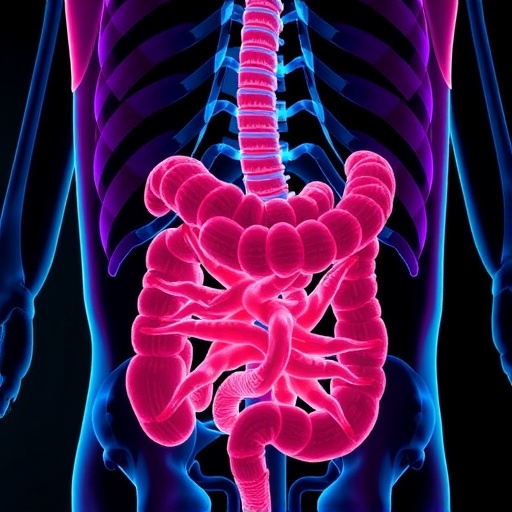
In a groundbreaking fusion of forensic science and artificial intelligence, researchers have unveiled a pioneering method for estimating the age of human remains by analyzing the coxal bone and lumbar vertebrae through post-mortem computed tomography (CT) scans. This innovative approach harnesses the power of convolutional neural networks (CNNs), a subset of deep learning algorithms, marking a significant leap forward in the accuracy and efficiency of forensic age estimation. The new technique holds profound implications for legal medicine, enabling experts to derive critical biological age data from skeletal remains with unprecedented precision and speed.
Age estimation from skeletal features has traditionally relied on subjective assessments and manual measurements by forensic anthropologists, often demanding extensive expertise and time. The coxal bone and lumbar vertebrae, integral parts of the pelvic and lower spinal anatomy respectively, are known to undergo morphological changes that can correlate with chronological age. However, quantifying these changes has remained challenging due to inter-individual variability and the subtlety of age-related transformations. By deploying convolutional neural networks to decode complex patterns within CT images, the research team has automated this process, extracting intricate details that escape human perception.
Computed tomography, with its ability to capture high-resolution, three-dimensional images of internal anatomical structures, offers a non-invasive window into skeletal morphology. Conventional age estimation techniques frequently require physical specimen handling or two-dimensional imaging, which limits data depth and introduces potential for error. The integration of post-mortem CT data with artificial intelligence not only preserves the integrity of remains but also leverages volumetric imaging to improve analytical granularity. This synergy allows the convolutional neural network to learn from large datasets, recognizing minute morphological signatures indicative of aging.
The convolutional neural network model employed by the researchers was trained on a comprehensive dataset of post-mortem CT images encompassing a broad age range. Through iterative learning, the network developed an ability to detect features such as bone density variations, trabecular patterns, and subtle structural degradations correlated with increasing age. Importantly, CNNs excel at image classification and feature extraction by simulating the human visual cortex, making them ideally suited for discerning nuanced anatomical changes. This ability transforms the task of age estimation from a qualitative judgment into a quantifiable, reproducible output.
Validation of the AI-driven method demonstrated impressive accuracy, outperforming traditional morphological assessment in several key metrics. The CNN’s predictions displayed strong concordance with known chronological ages, highlighting its potential for forensic casework, where establishing the biological profile of unidentified remains is paramount. The researchers emphasized how this development could streamline forensic workflows, alleviate expert workload, and reduce subjective bias—factors that are crucial in medico-legal investigations where timelines and precision are often critical.
The forensic community has long sought methods to standardize age estimation protocols, which have historically varied due to methodological differences and subjective interpretation. By introducing an algorithmic approach grounded in quantitative data analysis, this research represents a paradigm shift. The convolutional neural network acts as both a diagnostic tool and a repository of accumulated anatomical knowledge gleaned from diverse samples. Its deployment could lead to universal standards in age estimation, promoting consistency and transparency in forensic reporting and legal scrutiny.
Beyond forensic applications, the implications of this technology extend to anthropology, archaeology, and even clinical medicine. Understanding age-related changes in the pelvis and lumbar spine has relevance for studying human development, population biology, and degenerative diseases. The use of AI on post-mortem CT images can accelerate research into skeletal aging mechanisms with fewer ethical constraints than in vivo studies. Thus, the method not only solves forensic challenges but also offers a versatile platform for broader biological investigations.
Critically, the research confronts common limitations by incorporating a diverse sample population, ensuring the convolutional neural network is robust across different demographic backgrounds. Age estimation methods can be confounded by factors such as sex, ethnicity, and pathological conditions influencing bone morphology. By training on a heterogeneous dataset, the AI model reduces these confounders, enhancing generalizability. Future refinements may involve integrating other skeletal regions or combining multiple imaging modalities, potentially boosting the predictive power even further.
The use of post-mortem CT imaging also aligns with a growing trend in forensic sciences emphasizing non-destructive analytical techniques. Traditional autopsy and skeletal examination, while informative, can be invasive and culturally sensitive. CT scans preserve the remains intact while capturing detailed internal structure, serving both scientific and ethical imperatives. Coupled with AI, these scans transform into rich data sources from which forensic scientists can extract vital information with minimal physical intervention.
Convolutional neural networks rely heavily on computational infrastructure and high-quality imaging data, reflecting the intersection of advanced technology with forensic pathology. This marriage of disciplines underscores a broader movement toward digital innovation within legal medicine. As the volume of medical imaging data proliferates worldwide, AI algorithms will become indispensable tools for managing complexity and extracting actionable insights. This study exemplifies how meticulous scientific inquiry paired with cutting-edge machine learning can enhance human understanding and operational efficiency.
Despite the promise, the authors acknowledge certain challenges, including the need for extensive training datasets and the importance of model transparency. Neural networks are sometimes criticized as “black boxes” because their decision-making processes are difficult to interpret. Addressing explainability and ensuring robustness against image artifacts or variations in CT acquisition protocols are ongoing areas of research. Nevertheless, the demonstrated accuracy and repeatability of this approach represent a significant milestone toward routine forensic deployment.
Looking ahead, integrating AI-driven age estimation into forensic practice could substantially impact judicial outcomes. Accurate biological age determination aids in victim identification, legal age verification, and resolving ambiguities in cases of mass disasters or unidentified bodies. As AI tools become more accessible and user-friendly, even facilities with limited forensic expertise might benefit, democratizing critical capabilities worldwide. This technological empowerment carries the potential to improve justice delivery and human rights protections across diverse contexts.
The study also prompts reflection on the evolving role of human expertise in an era of artificial intelligence. Rather than replacing forensic anthropologists, AI serves as an augmenting partner, enhancing precision and allowing experts to focus on interpretation and complex decision-making. This collaboration between human and machine epitomizes the future of forensic science, where technology amplifies but does not supplant specialized knowledge. Such synergy may herald a renaissance in forensic methodologies, underpinned by data, innovation, and interdisciplinary cooperation.
Ultimately, this research reveals how intellectual curiosity and technological prowess can converge to address longstanding forensic challenges. The meticulous design of the convolutional neural network and its application to skeletal age estimation forge a new frontier in legal medicine. By transforming CT images of the pelvis and lower spine into reliable biological age markers, the study offers a robust tool with ramifications extending well beyond forensic identification. It is a testament to the transformative impact of artificial intelligence in unraveling the mysteries locked within human anatomy.
In conclusion, the integration of convolutional neural networks with advanced post-mortem imaging embodies a quantum leap in forensic age estimation. This method’s ability to decode complex bone morphology and generate precise age predictions not only enhances scientific rigor but also holds potential for wide-reaching societal benefits. The research stands as a beacon of innovation, illustrating how the fusion of cutting-edge AI and forensic science can illuminate new pathways in the pursuit of truth and justice. As this technology matures, its ripple effects will likely reshape protocols, challenge conventions, and inspire further exploration at the intersection of biology, medicine, and machine learning.
Subject of Research: Development of an AI-based method for estimating biological age from coxal bone and lumbar vertebrae post-mortem CT images.
Article Title: Development of an age estimation method for the coxal bone and lumbar vertebrae obtained from post-mortem computed tomography images using a convolutional neural network.
Article References:
Imaizumi, K., Usui, S., Nagata, T. et al. Development of an age estimation method for the coxal bone and lumbar vertebrae obtained from post-mortem computed tomography images using a convolutional neural network. Int J Legal Med (2025). https://doi.org/10.1007/s00414-025-03587-y
Image Credits: AI Generated
Tags: age estimation accuracy improvementsAI age estimationautomated forensic anthropology methodsconvolutional neural networks in forensicscoxal bone age correlationdeep learning in skeletal analysisforensic science innovationhigh-resolution CT imaging in forensicslegal medicine advancementslumbar vertebrae morphological changespost-mortem bone analysisskeletal age determination techniques




